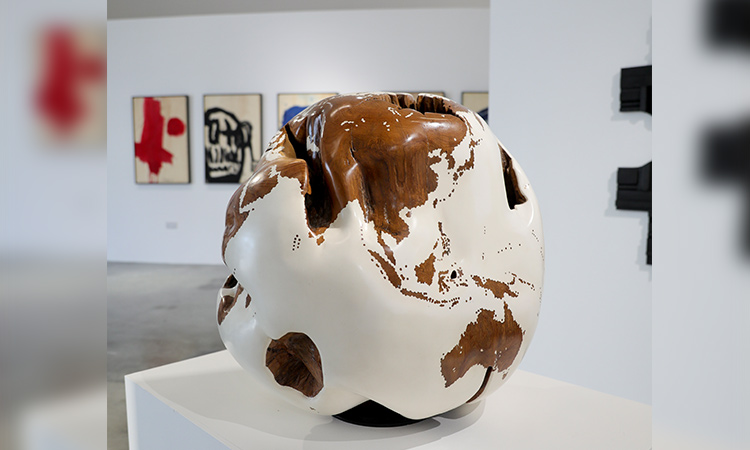Bruno Helgen’s poetic illustration of a globe.
Muhammad Yusuf, Features Writer
Firetti Contemporary and Amalgame Gallery are presenting WOOD you rather be happy, a group exhibition (Feb. 24 – Mar. 25) featuring the work of six international artists: Sawsan Al Bahar (Syrian-Palestinian), Laura Lappi (Finnish), Toma-L and Axel Chay (French), Taher Jaoui (Tunisian), and Bruno Helgen (French-Indonesian).
They use wood as their primary medium of expression. The show takes inspiration from American philosopher and naturalist Henry David Thoreau, who believed that nature is a critical factor in human happiness and well-being and that immersing oneself in nature was essential for personal growth and spiritual fulfilment.
With Thoreau’s words “took a walk in the woods and come out taller than the trees” in mind, the exhibition invites visitors to embark on an absorbing experience in an indoor forest filled with art.The diverse artworks, including installations, paintings, and sculptures, showcase the beauty and fragility of the natural world, with the aim of initiating a call for change in our relationship with Nature.
READ MORE
The Abrahamic Family House is abode of learning and dialogue
Jemima first film to hit screens in Pakistan on March 3
French documentary Spanish girl clinch top prizes at Berlinale
Utilising wood – a material with both natural and cultural significance – the artists emphasise the need for sustainability and collective awareness to protect and preserve our planet for future generations.They highlight the fact that all of us are part of the vast Earth, interdependent and interconnected, and there cannot be individual well-being without Nature’s well-being. It is not only a moral imperative, but also a prerequisite for a sustainable future for all. It is essential to living a happier, more worthwhile, and sustainable life.
In partnership with Azraq, a UAE-based environmental group recognised by UNEA of the UN Environment Program, exhibition visitors will learn about the importance of nature-based solutions for climate change, with a focus on managing and restoring ecosystems in the Emirates. The Magic Mangrove initiative, which has already planted 1,116 mangrove trees, is also being introduced, raising awareness of the value and dangers facing the UAE’s coastal ecosystem.
The core installation of the exhibition, Untitled Study for the Fall by Al Bahar, highlights the constant change and renewal that occurs in nature. The installation is a portrait of autumn, presenting sculptures of whirling, falling leaves.
Through image mapping, the artist transforms a collection of photos of trodden tree leaves, for the creation of the work in 3D-printed wood. Each leaf is imprinted with traces and layers of its environment, embedded with visual data that charts the season through moments of sunshine, drops of rain and specks of dust.
Al Bahar has chosen the species of maidenhair, misbelief and maple trees, known for their compelling histories of migration, adaptation and endurance. She encourages viewers to reflect on these forms of durational change and to engage with the work. Jaoui presents his series titled Garden of Hope, which captures the essence of Nature through the use of bold, vibrant hues and organic shapes and forms.
His 10-metre-long painting has been divided into multiple artworks: it is a metaphor for the idea of collective ownership. Garden of Hope is designed to evoke feelings of awe and wonder at the majesty of the natural world, while also emphasising the idea of our link with Nature.
Lappi showcases her signature wooden wall sculptures that are created using the ancient Japanese technique of Yakisugi, where she uses fire to preserve and finish wood, resulting in surprising final outcomes. Her sculptures, made from mainly recycled wood, raises important questions about the role of fine art in understanding the roots of our cultural and physical disconnect from Nature and how this can be addressed through art.
Toma-L presents his Wood & Black Shadows series which remind us that beauty can arise from the unexpected and the unforeseen. In Nature, nothing is perfect – but everything is perfect. Sculptures in the form of globes are offered by Helgen, where representations of the continents, nation-states, oceans, and seas that separate them, reflect ongoing dramas – tectonic, political, cultural, or religious – that continue to shape and define our world, are poetically illustrated. Helgen uses local wood from Bali, such as teak.
Chay’s standing sculptures serve as a tribute to the natural world and its beauty. The pieces are inspired by the sensual curves of a forest, honed and polished to distorted perfection at times. Thomas Labarthe alias Toma-L, born in 1975, currently resides in Nantes and works out of Marseille. His time spent living in Spain has had a significant influence on his work, with the colours of the south being a recurring theme.
Chay is a self-taught artist known for creating evocative and sensual works that pay tribute to women and the spirit of the Mediterranean Sea. Born in 1978 in Tunis, Jaoui’s work is heavily influenced by graffiti art, street art, African primitive art, cartoons, as well as abstract expressionism. He creates rich assemblages of layered forms, vibrant colours, expressive gestures and mathematical signs and formulas.
Born in 1959 in Paris, Helgen divides his time between Paris and Indonesia. He is known for his globes; each globe is an expression of the qualities of the wood’s natural form. Lappi’s (b. 1979) sculptural practice explores the relationship between physical spaces, man-made structures and the human mind – the psychogeography of places. Born in Damascus and raised in the U.A.E, Al Bahar is an artist, architect and researcher based in Dubai. She tries to uncover the discreet ways history influences personal narratives in the region.
